 Google’s fine is related to its Adsense program. Image credit: Google
Google’s fine is related to its Adsense program. Image credit: Google
Technology giant Google has been fined by the European Union over its advertising policies, which were deemed to break antitrust laws.
Facebook advertisers promoting housing, employment or credit offers will no longer be able to target ads by age, gender or ZIP code. The new ad policy applies to advertisers targeting U.S. users on Facebook, Instagram and Messenger.
The company said Tuesday that it will also launch a tool for users to search and view all current housing ads running on its platforms in the U.S., regardless of who the ads are targeted to.
Any advertiser running campaigns promoting housing, employment or credit offers will now have limited ad targeting measures. The move is part of a settlement Facebook has reached with the ACLU, NFHA and CWA which accused the platform of allowing discriminatory practices within their ad targeting options.
“There is a long history of discrimination in the areas of housing, employment and credit, and this harmful behavior should not happen through Facebook ads,” wrote Facebook Sheryl Sandberg in the announcement.
Facebook said multicultural affinity targeting will continue to be unavailable for housing, employment and credit ads, along with any detailed targeting options that describe or appear to relate to protected classes.

The times when ranking high in search results as the final goal have passed.
As search algorithms are improving and there’s no place for keyword stuffing anymore, SEO experts should adopt for trends coming and replacing each other too fast.
Today SEO involves loads of practices including link building, technical optimization, proper keyword research, and more. Although the process of boosting websites’ rankings is challenging enough, it isn’t the only task SEO specialists should cope with. To help businesses engage their target audience and make them convert is the problem falling to SEO practitioners as well.
Here comes the need for UX optimization, which is impossible not knowing what matters most of all for the target audience coming to the specific website. In this article, I’ll tell you about the most important steps to focus on for your customers and how to improve the user experience.
UX = CTR in some way. The debate about CTR among SEOs is evergreen, really. Everyone tries to defend his or her point of view despite Google’s statements on this issue. And recently, a new wave of discussion sparked up after the tweet of Moz SEO, Britney Muller. She tweeted about a new Google document that implies CTR matters for ranking.
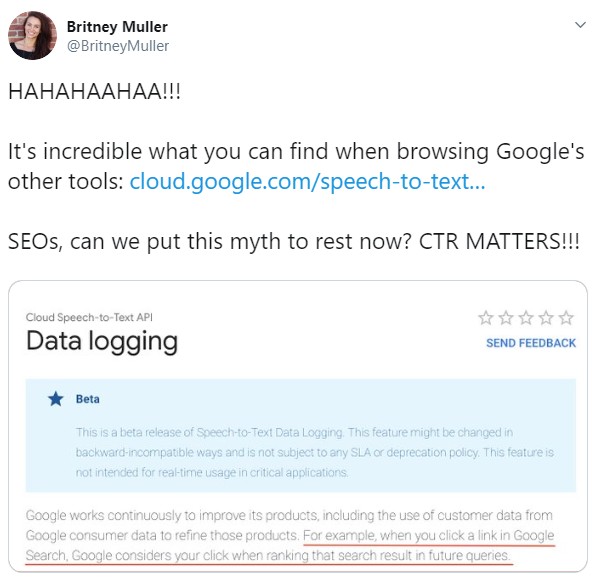
Different SEO specialists expressed their opinions and tried to confirm or deny this fact, as several weeks before that Google also said CTR for ranking is made up.
For example, Barry Schwartz said that this new doc is “Confusing. Google did write “when you click a link in Google Search, Google considers your click when ranking that search result in future queries.” They should clarify that it is used for personalized search.”
Also read: Google RankBrain: Clearing up the myths and misconceptions
Regardless of all these debates, CTR and UX itself is a great practice. Even if it doesn’t improve your rankings, it’ll make your site more understandable, comfortable, and informative for visitors.
It may seem that being number one on Google search results is key to an engaging audience and driving conversions. It’s not quite so. Every improvement of search algorithms Google brought in recent years is focused on providing user-friendly results. Of course, domain authority and quality links are still important, but if the website ranked top has poor user experience, it may lose its positions soon.
How does it happen? Well, let’s assume your website is technically optimized, has a perfect content-to-keywords balance, and has links even from .edu domains. All these factors are most likely to result in high rankings.
But if the site is not fulfilling users’ expectations, it may take a dip as quickly as it’s rocketed. Once people that clicked through your website aren’t satisfied with the result, they’ll leave it quickly. The next time Google updates search results, it’ll see that your page’s bounce rate is too high.
The numbers will point to the fact your site isn’t relevant to the query, and it shouldn’t rank that high.
Bounce rate isn’t the only factor search engines consider when analyzing user experience. There are also such signals as pages per session, dwell-time, and organic CTR. As you see, the tasks of an experienced SEO specialist are much broader than it used to be several years ago. But the results cost the effort.
The good news is that you already know these practices. The only difference is that using them now, you should concentrate not on the search engines’ requirements but on meeting the needs of your visitors.
Let me take you through the user’s journey point by point and emphasize on crucial aspects influencing his or her decisions. Here we go.
Where does the search journey start? Right, everything starts from the query. Once users have questions, they go to search engines and ask them. That’s why knowing what your potential customers are likely to look for is half-way to success.
The knowledge of queries your target audience conducts helps you come up not only with content ideas but also with key phrases your page should rank for. There are several questions you should answer to make your keyword research user-focused:
The thing is that every user conducting a search query has a certain intent. In other words, there’s always the reason why a person searches for something. If I search for “iPhone price”, there’s a 90 percent probability that I want to buy the smartphone. In this case, Google will provide me with various online stores. Searching for “Apple or Samsung”, it’s most likely I want to read the articles where authors compare devices produced by these two companies. And again, the search engine will get it.
Therefore, it’s essential to denote the intent of the content you provide. If you own an online shop, you should mark transactional intent on your page. Add “buy”, “price”, “purchase”, “on sale”, and other related keywords. If you run a blog, use the phrases with “how to”, “what is”, “best tips”, and more. Denoting intent not only helps search engines rank your website for the relevant queries but also provides users with a better understanding of what they’ll see on your page.
Moreover, users quite often don’t mark their intent in their search queries. One can type “women jeans”, and the machine won’t be 100 percent sure whether a person wants to get some fashion tips or purchase jeans. In this case, the search results will contain both informational and transactional websites. To help your prospects understand if they should click through your site, you’d better denote what type of service you provide.
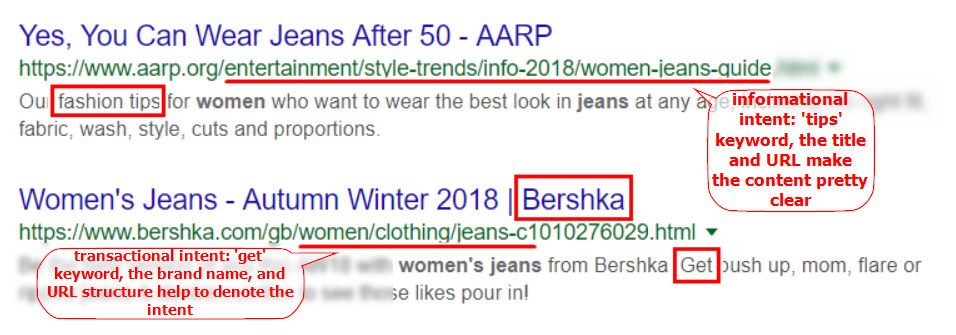
Even if you think you understand what kind of information concerning your product your target audience may be interested in, don’t jump to conclusions. Working in a niche is pretty different from being a consumer. The words you use to describe what you do may be absolutely unknown for people searching for your product at first.
As we concluded it’s important to know what kind of search queries your potential customer’s conduct. I’ll show you the quickest ways to identify these queries.
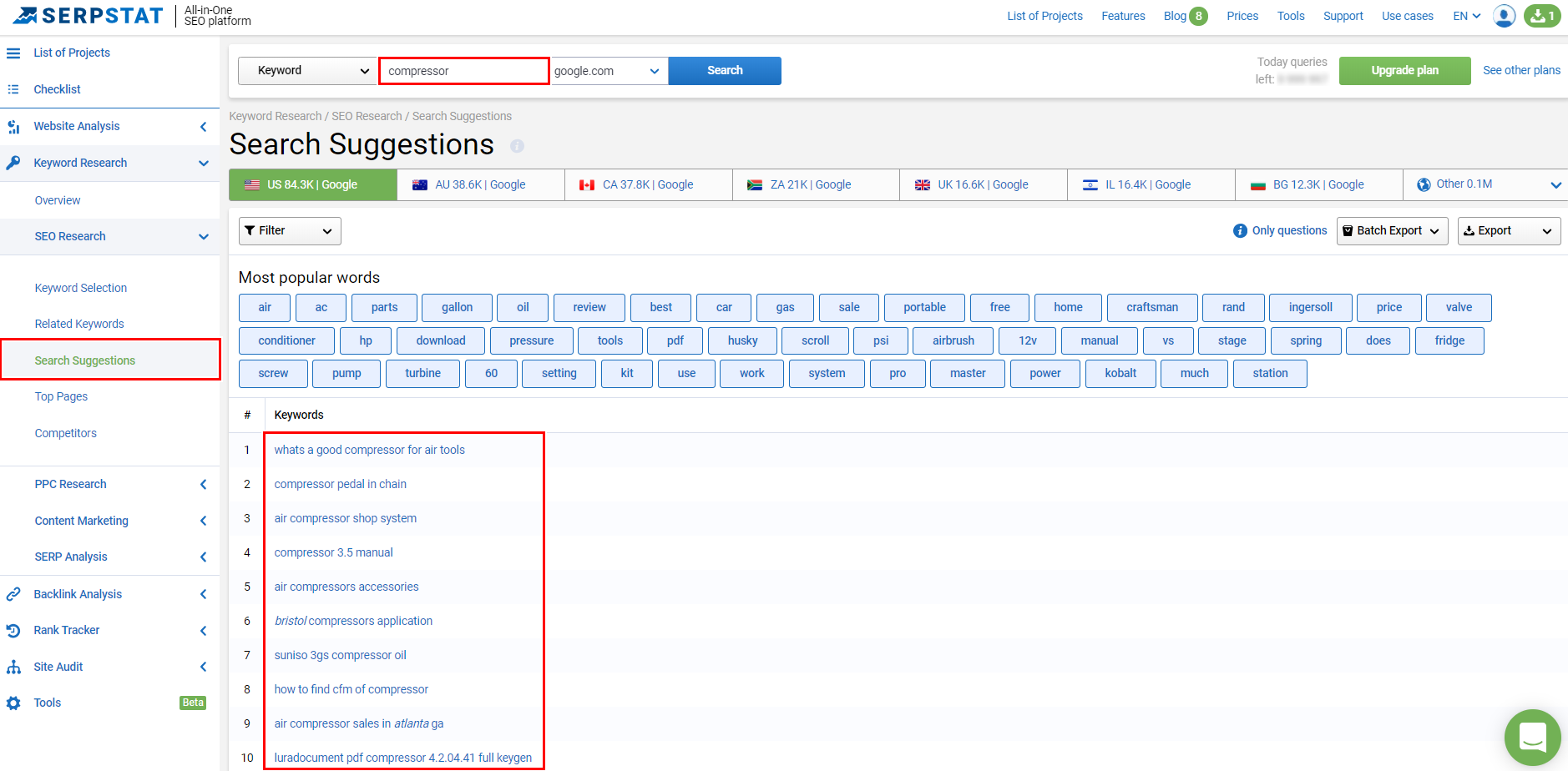
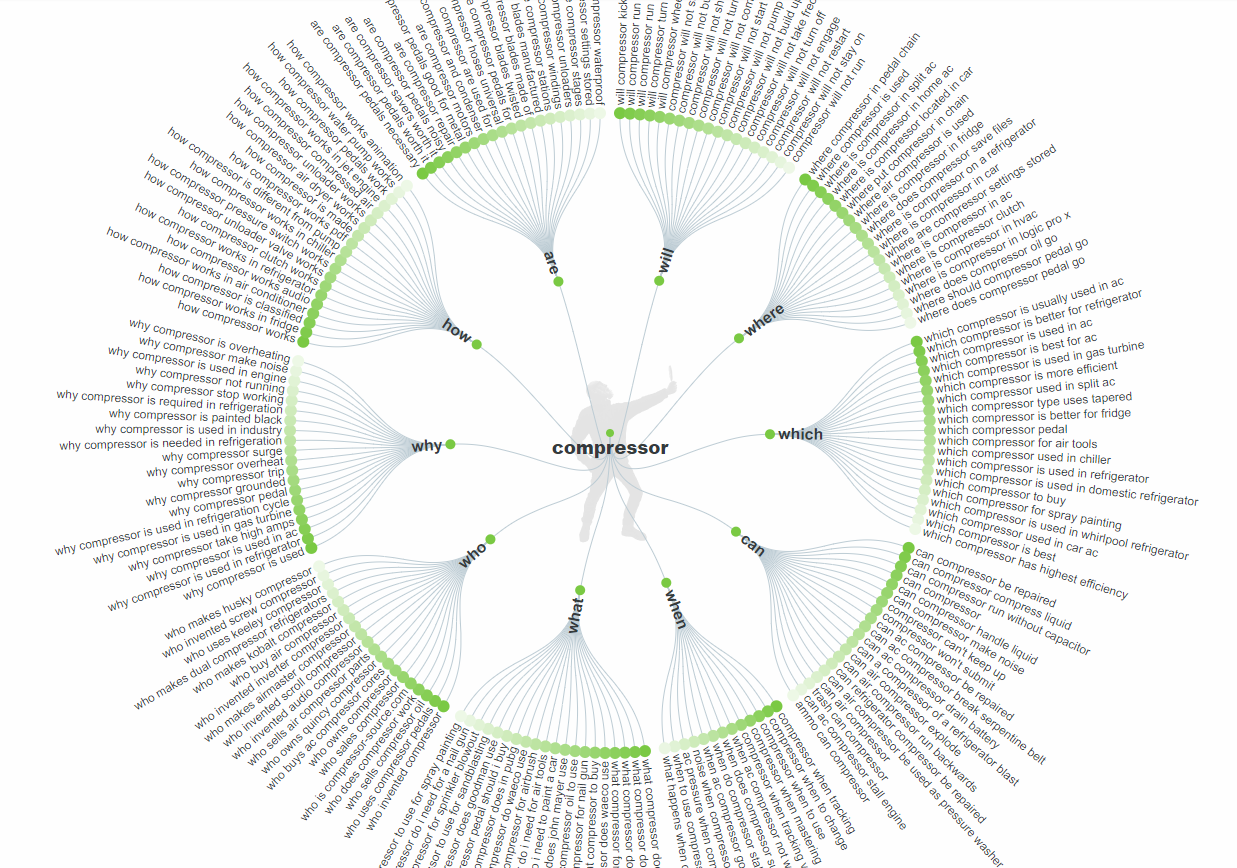
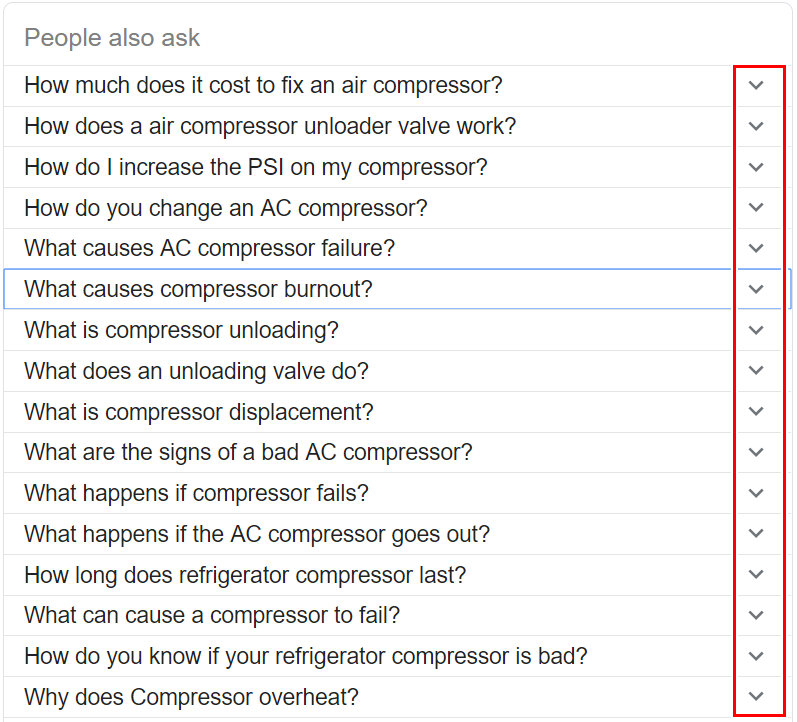
The next step users undertake after entering the search query is choosing which website from all the search results provides the most comprehensive information. And how do they make a decision? Right, they judge by what they see in the snippet.
The website may contain high-quality and relevant content, but failing to denote it in the snippet, decreases its chances to get high traffic dramatically. In fact, there are two pieces of metadata influencing how your snippet may look.
Of course, creating a catchy and intriguing title and description is essential in case you want to attract the audience’s attention. But you should be careful. In the way, a boring title will bring you little profit, the too promising one will also do you no good.
You may say: “There are loads of posts on the subject, I should make my page stand out.” I agree. Partly. You should stand out. But with unique and quality content, not with false promises in your snippets.
Once you promised something that you don’t provide on your page, it’ll increase your bounce rate and hurt user experience.
So, when creating a title tag and meta description, make sure you:
After your audience clicked through your website, there’s one more thing they’ll face before seeing the page itself. Page speed is the factor considered not only by search robots but also by users.
If a person (especially a mobile user) should wait for more than several seconds for your server to answer, the chances he or she will return to search results are quite significant. Here’s an infographic by HubSpot.
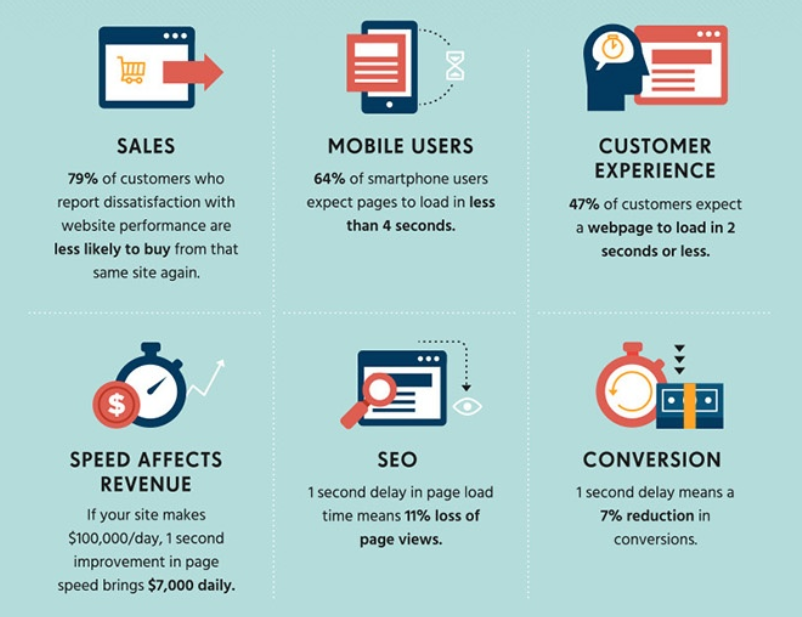
There are services, such as PageSpeed Insights, Serpstat, and Moz, which analyze web pages’ loading speed and generate suggestions to make them faster.
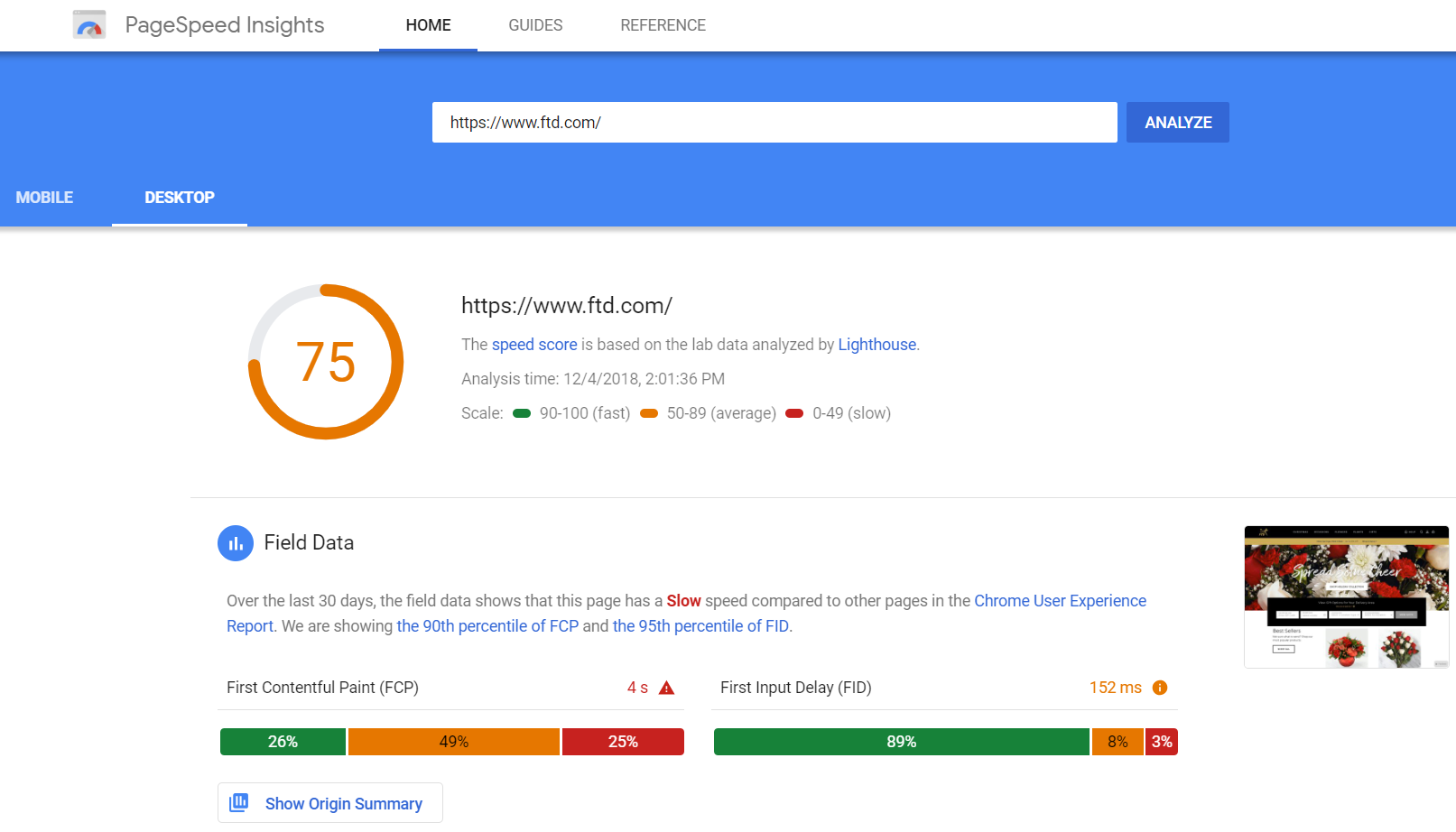
Never forget that 48.2 percent of web page views worldwide account for mobile device users. So, if you don’t want to damage the user experience, it’s worth checking whether your website is mobile-friendly or not. Click on “mobile” to see the analysis of your mobile version. You may be surprised to see that these two versions differ a lot.

When people have already chosen your website, clicked through it, and waited for it to get loaded, they see your page. What’s the first thing catching the visitor’s eye? The way it looks. Your content may be incredibly authoritative and trustworthy, but once users see it’s impossible to draw the essential data quickly, they might decide the content is too complicated.
I’ve circled out a few tips for you to follow when elaborating your content structure and design:

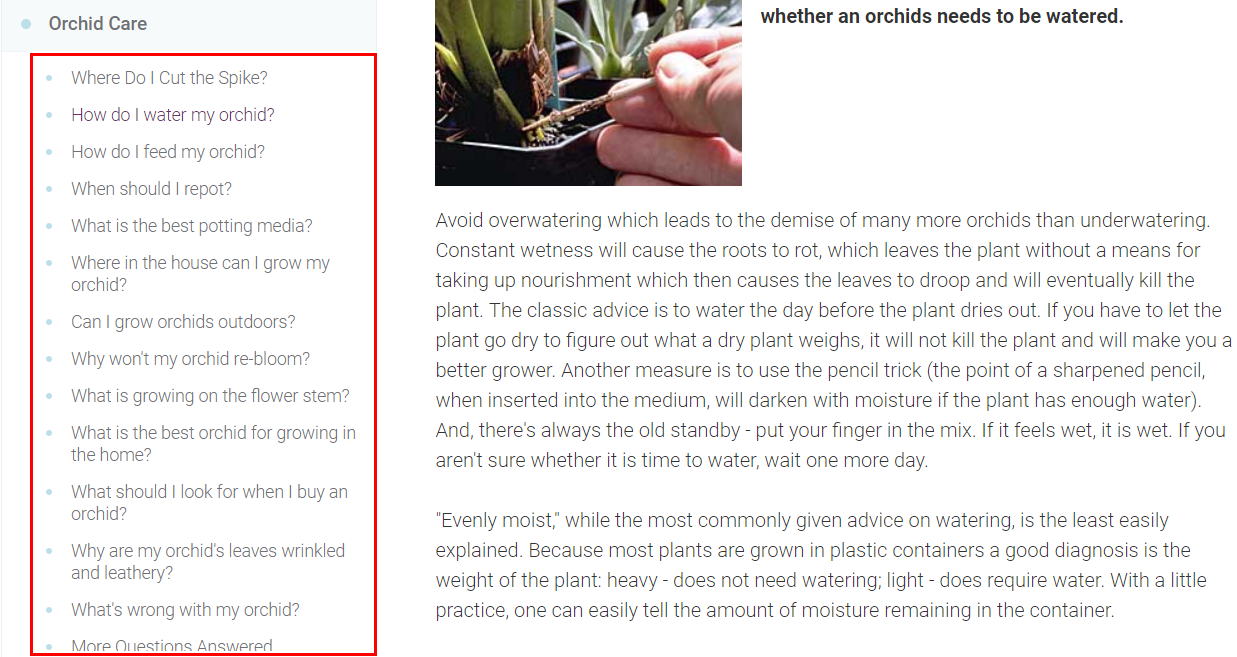
Mind that lots of visitors don’t come to your website from your home page. Make sure your website is easy to navigate for users to visit different pages of your website. Remember that the more time people spend on your site, the better the user experience it causes.
First of all, your menu button (or hamburger button) should always be handy. It would be the most convenient to create a fixed header for your web pages. Due to such a header, visitors won’t have to scroll the page after they’ve read your content.
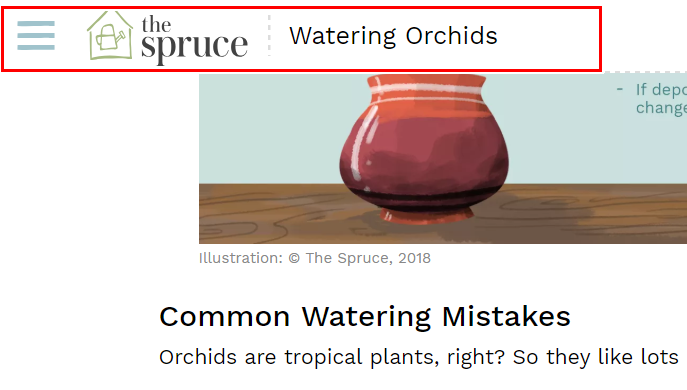
Moreover, when unrolled, the menu shouldn’t overlap the page content. Talking of overlapping, try to avoid pop-ups. All the advertisements overtaking the article every minute cause extremely poor user experience.
Don’t forget to provide clearly labeled categories on the menu. Everything should be organized logically. To make your website even more convenient in the usage, add a search box. If visitors aren’t sure which category contains the necessary information, this box will help a lot.
Here were the basic tips which may help you improve UX for your website. Following them is the start, not the finish line. UX tendencies are changing almost as often as search algorithms do.
Always look for ways of improving your strategies. Track users’ reactions to your new posts. ask yourself, “Did the conversions improve when you applied a new design?” Analyze all the changes whether they’re good or not and discover how you can develop user experience.
Inna Yatsyna is a Brand and Community Development Specialist at Serpstat. She can be found on Twitter .
80% of users admit that a poor search experience can make them leave a web store. How faceted navigation in ecommerce can make or break their experience.
Five strategies to help digital marketers speed up recurring tasks and have more energy to focus on meaningful work. Scripts, excel, bidding, and more.
If there’s one thing that’s universally accepted, it’s that the results of SEO are unpredictable. An overview of SEO forecasting methodology and measurement.
Boston-based Teikametrics announced the addition of an hourly bidding solution for Amazon advertisers using Teikametrics Flywheel campaign optimization platform Monday.
The company says the bidding algorithm is powered by machine learning and analyzes ad data, transaction data, and importantly, cost of goods sold data. The algorithm analyzes bids hourly to make adjustments when needed. “Amazon is continually providing more and more access to data and API opportunities, along with more ad units,” said Alasdair McLean-Foreman, CEO of Teikametrics, by phone Monday.
Teikametrics refers to Flywheel as a retail optimization platform (ROP). “We consider this a new category,” said McLean-Foreman. It’s a different use case, said McLean-Foreman, because the transactions from ad engagements happen right on Amazon, unlike ads on Google or Facebook. The platform using machine learning to optimize pricing, operation and inventory performance for Amazon advertisers.
“We can see the transactions and profitability. The brands don’t give Amazon cost of goods sold data, but they give it to us,” explained McLean-Foreman. With that combination of data — ad, transaction and cost of goods sold — the algorithm can optimize bids for profitability.
McLean-Foreman compared the hourly bidding algorithm to a digital thermostat that can regularly check and react to climate changes to maintain a steady room temperature. “The bids don’t change every hour by default,” he said. Instead, it checks the bid status more regularly to deliver more consistent optimization.
“The longer you have an under-optimized bid, the more it’s going to cost you,” said McLean Foreman. The scale of data — it claims $6 billion in retail sales has gone through the platform — and optimization frequency means its hourly algorithm can deliver millions in increased profitability for sellers, said McLean Foreman.

For some businesses, there is only a small team, or even one individual, in charge of all the pay-per-click, or PPC advertising.
And that one person, or team, may have other responsibilities that cut into that PPC management time. As the business grows, keeping up with all the work that goes into a well-managed PPC account (or multiple accounts) can be difficult. So it may be necessary to outsource some, or all, of this workload.
The challenge now is to find the right PPC software or management company. The purpose of this article will be to help you identify the needs of your business and what to look for in companies or software that best fits those needs.
There are many options available to small businesses for PPC advertising management including tools and specialized software, all the way to full-service PPC management agencies. The decision to go with one over the other depends on three things:
If you want to keep full control of your accounts, devote some time to managing them. And if you’re working with a conservative budget, then a PPC management software may be perfect. However, if you don’t mind handing over the reign, or have little or no time to spare, and can afford the extra expense, then a full-service PPC management agency might be right for you.
Read also: 10 reasons to hire a PPC management expert.
Not all businesses are going to fall into the these options, and most will actually be somewhere in between. Other considerations to be taken into account when identifying your businesses’ needs include the number of PPC accounts you have, average monthly spend, ad type mix, and whether you currently manage PPC manually or with automation.
PPC accounts could include one, all, or a mix of the following:
I was recently tasked by my company to research and create a top three list of PPC management companies, or software tools, in order to free up my time to work on our websites.
So I began my search for companies that provide these services and software. After compiling a list of the ones I wanted to investigate further, I signed up for software demos, free trials, free PPC audits, or free phone consultations.
Below are some details of my research into these companies. This is clearly not an exhaustive list of what’s available out there, but it’s a helpful guide if you’re unsure of where to start.
Features: Free PPC audit with follow up consultation and demo of software designed for Google Ads and Google Shopping feed management. Management services include PPC lead gen, paid search, Amazon, and Facebook.
Pricing: Not listed on their site, but during the consult, they provided a price range based on current accounts and recommended services. The estimate I received for the company I work for, was a range of $2,500 to $3,500 for the one-time setup fee, plus 25 percent of our monthly ad spend.
My research experience: Sign up for the audit and demo was easy and they contacted me pretty quick about getting me set up. I had the consult call which lasted 45 minutes and was a detailed overview of our accounts including areas that were working or not working in our favor, how they could be improved, and how they would help solve these issues as well as improve our overall account performance. After the representative went over the audit results, it was recommended that we go with PPC management services rather than the CAPx software alone.
Final impression: I was really impressed with the detailed results and feedback I received about our account. Using the software without managed services was definitely not something that would be beneficial for us, nor could we use it to manage Bing Ads. The pricing was also quite high, more than what we can fit into our budget. Their PPC management services did sound robust and valuable, just not the right fit for us.
Features: Full-service management with dedicated account management, research, analysis & strategy development, comprehensive optimization, and custom reporting are all included in their listed services.
Pricing: Pricing not listed on their website but was in the proposal. Fee schedule is based on the monthly ad spend as follows: 13 percent for more than $5,000 monthly spend, 15 percent for $3,000 to $5,000 monthly spend, or a flat fee of $399 for less than $3,000 monthly ad spend, per account.
My research experience: Sign up for the free consultation was easy, but no audit was performed first. Consult call was about 15 minutes and we reviewed what kind of accounts we currently have, what we’re looking for, and more. Received a proposal a few days later that included a high-level overview of services they provide along with their fee schedule.
Final impression: Although quick to set up a call after the sign-up, the call was too short to fully understand our needs and accounts. It took a few days to get the proposal and it was very generic, not designed around our businesses’ specific needs. Looking back at their website, there are no testimonials from clients, very basic high-level content, and very little company information. We did have a good call and their representative was great to talk with, so it’s possible that the customer service could be great. I would recommend further research.
Features: Integrated service offerings include digital strategy, ad copy, PPC analytics, display and paid search, dedicated PPC account manager, and an account specialist with weekly, monthly. Plus, ad hoc client calls with weekly and monthly reporting.
Pricing: One time new client fee $1,495 includes utilization of Google Ads and Bing Ads, plus a monthly management fee based on the monthly ad spend, broken down into tiers starting at $600 (up to $3,000 in ad spend) to 10 percent (at $30,000 to $150,000 in ad spend).
My research experience: Signed up for their free PPC audit, which they linked directly to our Google Ads account, and then sent a detailed report within a few days that included specifics of actionable items, and a description of the on-boarding process. The audit report features JumpFly agency intro, audit (initial thoughts), and specific areas they see that need work.
Final impression: It was a very simple process for the audit and the report had lots of details, specific to our account, of how to optimize, and grow, our account. The report was comprehensive, not simply focusing on their service. They even had simple, actionable items that I could immediately implement. The pricing seemed reasonable enough for what we’d get in return. The company also had a very thorough website and appears knowledgeable and trustworthy.

Features: As described on the website, “Automated Optimization Suggestions: ProAdly constantly analyses your AdWords account and calculates suitable suggestions and optimizations. Optimizations are calculated and weighted with the expected impact. Potentials for savings and growth are shown. Suggestions for optimizations are shown for: Google Shopping bid optimization, ad time planner, device planner, good & bad keywords, text ad creation, quality scores, and keywords.”
Pricing: A free 14-day trial offer plus a free live demo. Pricing is based on the number of AdWords accounts and Merchant Center accounts. Up to five accounts – $250 per month; up to 25 accounts – $459 per month. Discount available if paying annually.
My research experience: The trial was easy to get started and set up, bringing in your accounts. The recommendations it gave were decent, but there were times that my accounts gave me suggestions, and this software did not. It was very simple to use and straightforward on what it does (and doesn’t do).
Final impression: A big con was it’s designed for Google AdWords only, no Bing Ads management. I was also unable to find any training, but there’s a live chat box and an article finder to ask for help. That being said, the software is not very comprehensive. The only thing I can see that it does is offering recommendations to optimize your account, but you can’t create campaigns or do any re-structuring within the software. That being said, if you want something that can offer suggestions on dozens of Google Ads accounts in one place, then this may be helpful on a day-to-day basis for quick optimizations.
Features: PPC management software suite includes account management for Google AdWords, Bing Ads, and Google Shopping feeds. One-click optimizations, data insight tools, report designer, quality score tracker, Bing tools, Google Ads scripts, Google Shopping campaign tools, advanced reporting features, advanced shopping features, rule engine and custom optimizations, custom domain for reports, training sessions (two personal sessions with PRO accounts, email support, all accounts linked to software (no limit), and spend per month linked up to $500k. Plus, automation credits (250 free credits per month for a Pro account).
Pricing: Regular $499 per month for a Pro account (discounts for six months or annual payments). Enterprise level available, have to contact for pricing.
My research experience: The free 14-day trial was easy to sign up for and I was able to quickly pull in all our AdWords accounts, analytics accounts, Bing Ads, and shopping feeds. It was nice to have everything in one place. The software gave decent recommendations. Training is offered with a free Udemy private training course.
Final impression: A very comprehensive software that was impressive. Plus, for us, we’d be able to manage all of our accounts in one place. Ability to create ads, create structure, and set up custom rules. The price is really great for what this tool can do. I think this is the perfect software for someone who has a really good working knowledge of PPC accounts, and knows what needs to be done (as far as structuring). After the initial work of getting everything set up and creating rules, it will definitely be a time-saver as well.
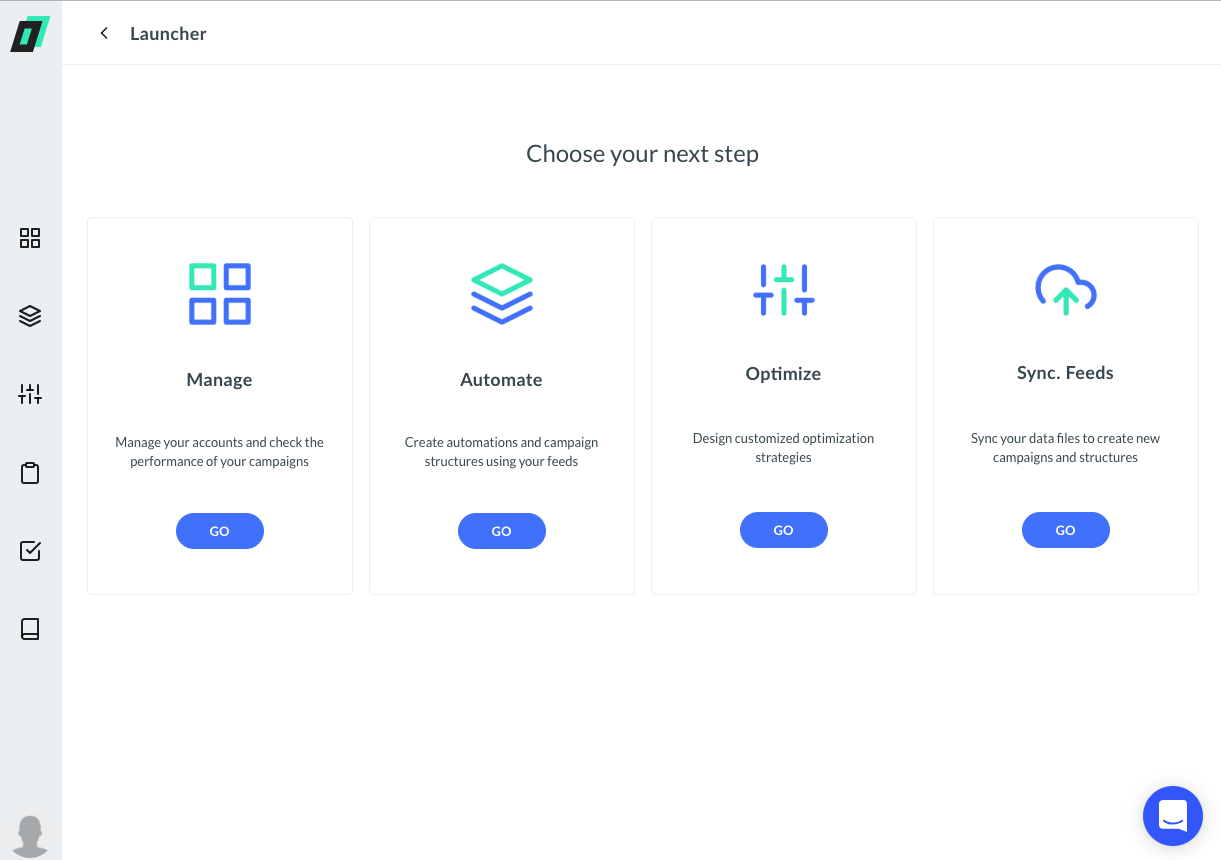
Features: The description on their website, “Spaceboost combines creative automation, campaigns operations automation, powerful 24/7 bidding algorithms, and outstanding customer service to help 5,000+ brands scale their results – not headcount – on Google, Bing & Amazon.”
Pricing: On their website, they have a very cool sliding scale that includes different packages of software with or without mentoring, and with or without managed services, at different business levels. Based on my company’s monthly ad spend the approximate cost for us is as follows: Software alone $1,000, software without mentoring $1,500, or software with mentoring, and managed services $2,250.
My research experience: Very easy to sign up for a free 30-day trial. There is tons of training videos plus support via email, chat, and phone. Free academy training is also available. That being said, it was a bit overwhelming and I wasn’t sure how to use the software, so I requested a free demo. I had a consult call with them for about 30 minutes to explain how it all works, discussed our business needs, and received recommendations, based on our business and customers for which package would be right for us.
Final impression: The software is fantastic and pulls in all of your inventory in basically any format you want. Then all of your accounts and ads can be structured around that data, or you can continue with the structure you already have. Their managed services are also incredibly flexible, you can use them as little or as much as you want. Although the software was more advanced than what I would want to use if I was going for software alone. However, if you looking for a mix of software and managed services, want to save a ton of time, but want to still retain control and decision making, then this might be the perfect solution.
With hundreds of PPC software tools and management agencies, how do you know which to choose? Knowing what your business needs, what you currently have in place, and what you hope to achieve with PPC services will help you navigate these waters.
Knowing what to look for in software capabilities and features, or with agencies and their services, will help you make an educated decision. Also, check into the company, look for reviews, see how long the company has existed, and who are their clients. Take your time, know your business, and do your research.
Got any first-hand experiences with PPC management solutions, tools, and services? Share them in the comments.
About 60 percent of B2B companies acquired customers through LinkedIn paid ads. Ace B2B paid advertising with these strategic tips on execution.
Kenneth Andrew of BingAds gives us tips for how to get more value from our paid search spend. Are you keeping up with these industry trends?
How is Prime Pantry advertising different than overall Amazon Ads? Here’s what you need to know about maximizing paid search for Prime Pantry.

Digital out-of-home advertising is evolving so far beyond just being video billboards that, like mobile, the channel category may soon split into multiple channels.
For Gregg Witt, chief strategy officer at youth-oriented marketing agency Engage Youth, outdoor digital screens can be seen as an extension of social media.
There is “so much noise in [conventional] social,” he said. But, when curated Instagram posts are displayed on a digital screen outside a concert or some other event, it becomes “a canvas, an opportunity for the new generation to be part of the experience.”
This also elevates the status of any event-goer whose Instagram post gets selected and shown, he said. In multi-channel campaigns, Witt said he considers DOOH to be most effective at the top of the funnel, generating awareness of a product — not unlike broadcast TV ads. Outdoor ad firm OUTFRONT Media says that DOOH introduces a brand, and an accompanying social campaign can offer “a personal invitation to engage with that brand’s culture.”
In fact, the pairing of outdoor digital screens and social media on mobile devices has emerged as a distinct kind of user experience. Brick-and-mortar stores, for example, commonly display large screens, along with an invitation for customers to post their images into a continuing feed. In this mode, DOOH screens become a kind of ad hoc projector for visitors in a retail experience.
Earlier this week, DOOH marketing platform Broadsign announced a partnership with outdoor advertiser Starlite Media to update its thousands of traditional, static screens into digital ones. But the transformation is not just to video versions of Starlite signs. Instead, the companies said, the screens are becoming informational kiosks inside thousands of retail outlets.
To get to those retail outlets, many customers drive. That fact means there’s an emerging channel that can follow the would-be customer out a home’s front door via location-based messaging to a smart phone, pick up the campaign thread in an apartment garage, continue in the car’s dashboard screens and culminate in ads in a store’s displays and on the user’s phone.
Location platform service HERE, for instance, has partnered with mobile platform Verve to expand on this newly targetable “customer journey.” Verve CEO Tom Kenney said via email that the companies see a traveler’s journey as connected steps in this emerging channel.
“The mobile space has changed the underlying flow of that conversation,” he said. “Since the automobile and the out-of-home screen increasingly speak the same data language as the phones and tablets consumers already know and love, we’re talking about cars and DOOH as new participants and new opportunities for any kind of brand.”
Another variation of this trend to see cars as moving inventory are the screens showing ads as well as content in the back of cabs or, as Washington D.C.-based Octopus does, in the back of Uber and Lyft rides.
In fact, one of the biggest reasons that DOOH is splintering as a category is that wirelessly connected screens will become available for virtually any surface, a possibility made more realistic by the coming of 5G.
Vengo, for instance, is a service that offers digital vending machines, but the large screens in the machines are also used for ads unrelated to the vending machine’s offerings.
David Weinfeld, Sales Director of Publisher Solutions at marketing agency Vistar Media, said via email that “advertisers are increasingly looking to engage with consumers through a combination of unique place-based activations,” including gyms, office buildings and schools. And the combo of physical location, the customer’s selection of a vending machine product and mobile location data help to pinpoint the ad to the audience.
Jason Kuperman, Chief Product Experience Officer at OUTFRONT Media, pointed out that the integration of DOOH into the programmatic ecosystem and the use of mobile location-based data is moving out-of-home advertising from buying a sign at a given roadside location to buying audiences, as the rest of the digital world does.
Advertisers don’t pay for TV screens, he pointed out. They pay for audiences, and that’s what’s beginning to happen in DOOH.
This kind of targeting, he noted, is going hand-in-hand with context-specific messaging on DOOH inventory.
Kuperman pointed to a JetBlue campaign run by OUTFRONT in New York City’s Times Square, which incorporated real-time traffic and flight schedule data. Essentially, those ads were customized for viewers based on third-party data. He pointed out that, increasingly, advertisers will also take into account the longer dwell time of certain DOOH locations, such as the estimated four to eight minutes in front of a screen that is located on a New York City subway platform.
Similarly, OUTFRONT offers DOOH screens accompanied by geofencing, so that mobile devices can be targeted in coordination with the larger displays. Again, this is a new way for advertisers to pinpoint audiences when they make their purchase decisions.
David Etherington, chief commercial officer of DOOH exchange Place Exchange, said his recently launched company is creating “viewing sheds” around DOOH screens, via third-party data. This lets the advertiser know nearby device IDs, and see if those mobile devices visit a web site that has been promoted in the large screen.
SurveyMonkey ran a DOOH campaign in Times Square, which showed four influential celebrities — publisher Arianna Huffington, basketball player Draymond Green, tennis player Serena Williams and LinkedIn CEOJeff Weiner — inviting opinions from viewers. Passersby could launch a related online survey from their phones after scanning QR codes near the DOOH display.
But all of this is only the beginning of DOOH’s evolution beyond its static billboard heritage. One possibility envisioned by Engage Youth’s Witt is the implementation of augmented reality (AR) — viewed through smartphones and eventually glasses — as a common overlay on digital billboards, especially in retail environments.
DOOH advertising in the U.S. is booming, hitting what the Interactive Advertising Bureau said was a record high in 2018 of $7.4 billion. OUTFRONT Media says that consumers spend 70 percent of their time out of home, and that they are 48 percent more likely to engage with a mobile ad after seeing it on a DOOH sign.
With so many permutations on the form, including an infinite number of inventory locations, screen types and interactive modes, DOOH is positioned to become a huge component in many campaigns — as an extensive continuation into the real world of the messaging efforts that have previously been largely confined to the dimensions inside TV and the web.
This story first appeared on MarTech Today. For more on marketing technology, click here.
Opinions expressed in this article are those of the guest author and not necessarily Marketing Land. Staff authors are listed here.

Who can argue that building an SEO strategy is not a time-consuming thing? Keyword research, niche analysis, technical audit, link building — all these tasks are just a small part of an SEO’s daily routine.
Willing to automate search engine optimization processes, experts use special tools and software. But it’s not always sufficient when analyzing the results
Of course, solving some basic issues for a small website isn’t that difficult with quality SEO tools. On the other hand, if you work with several sites and analyze lots of data, you’ll need to find ways of saving your time. At this point, people may look into implementing other methods into their working process. Here usually come various SEO extensions and plugins. They are very convenient as you can activate them in one click right from the page you’re analyzing.
However, extensions often have even fewer features than the SEO tool itself. If taking a closer look at the issue, there’s one more decision to be found. I’m talking about APIs, the method few people know how to use, missing the opportunity to benefit a lot. In this article, I’ll tell you what an API is, why you need it, and how to use it to fulfill SEO tasks.
API stands for an application programming interface. It’s a set of functions that lets users get access to the data or components of the tool. In other words, an API is a set of methods of communication among several applications.
APIs may serve for various purposes. For instance, developers often use them to embed some objects into websites. If you see a piece of Google Maps on a site, it means that the Google Map API is being used there. The same may be done with apps or tools.
The right API helps experts to simplify the whole process of data collection. Some SEO tools offer an opportunity for their customers to use their APIs and drive better results. It lets users integrate analytics provided by platforms into their custom interface tools. With an API, you can request data and get it, while not even managing the tool’s interface.
As previously mentioned, APIs let you make your SEO research much more flexible than typical tools do. So, what tasks exactly do APIs help with, and how can you use them for maximum profit?
While SEOs have various issues to deal with, there are different platforms created to facilitate keyword research, niche analysis, content curation, and evaluation of the results. Some of these tools provide APIs to make the research even more effective. Below you’ll find the tasks an API may help you cope with and the tools providing such a method for their customers.
A comprehensive niche analysis and proper keyword research are the first tasks appearing in an SEOs’ to-do list when they get to a new project. SEO tools meet these needs very well. Unless you don’t want to spend your time analyzing each competitor or keyword individually. For this purpose, quality tools provide their APIs.
With Serpstat API, conducting complex research becomes easier than ever before. The thing is that working with it you don’t even have to know how an API actually works. Serpstat has created several documents with scripts already implemented there. It means that all you need to do is to enter your token and create your request. This document allows you to take advantage of all the Serpstat API methods in one place.
This API includes domain analysis, URL analysis, and keyword research features. It provides 17 reports on competitors, domain history, top pages, related keywords, missing phrases, and more. For example, if you want to know your competitors’ domains, you can do it in several clicks without spending limits on analyzing each website separately. Here’s a step-by-step instruction on how you can do that.

Step 1: Generate your token in your Serpstat account. Starting from Plan B (69$ a month), every user has access to the API. If you don’t have one, contact the support team via live chat to discuss options.
Step 2: Open the document and make a copy of it.
Step 3: Enter your token into the cell.
Step 4: Select a database from a dropdown list.
Step 5: Enter a list of your competitors’ domains.
Step 6: Choose domains > Domain info report in Serpstat tab
Step 7: Watch the following results

Knowing the most trending topics and articles is the basic thing everyone who wants to attract their target audience needs to know. Moreover, tracking your content performance helps publishers improve their strategies to drive higher traffic and engagement.
As blog owners usually run lots of documentation to provide reports on their marketing results, integrating tracking tools into their own applications is extremely useful and helps save time a lot.
The Buzzsumo API provides a wide range of filters. Applying them, you’ll get highly specific reports that handle content creation processes for you. You can not only analyze your pages but also see your competitors’ top articles. Such reports will help you come up with the most engaging types of content.
Its standard API has five resources:
Links shared API request and response examples:

Backlink analysis is another essential part of SEO. This process helps people see their link profiles’ weak points and discover new link building opportunities.
To integrate your applications with backlink analysis reports, you can use Majestic API. It’s available on Platinum and API plans. The full API lets you discover the following information:
Running a website and not analyzing the results it gives is a complete waste of time. So, it’s pretty difficult to find a person who owns a website and doesn’t have a Google Analytics account. The tool provides you with a deeper understanding of your audience, evaluate your marketing performance, and helps you find out what tactics that are working the best. However, accessing this data via the tool itself isn’t always convenient.
Website owners often need to build custom dashboards and integrate their analytics reports with their business applications. For instance, if you want to create a KPI dashboard for your marketing team, integrating Google Sheets with Google Analytics will be the best decision.
The Google Analytics reporting API allows users with the following:
To combine the power of Google Analytics API with the power of data operation in Google Sheets, use the Google Analytics spreadsheet add-on. It’ll let you compute custom calculations, schedule reports creation, share the data with your team, visualize your reports and embed them to other websites. To install the add-on, read the step-by-step instruction by Google Developers.
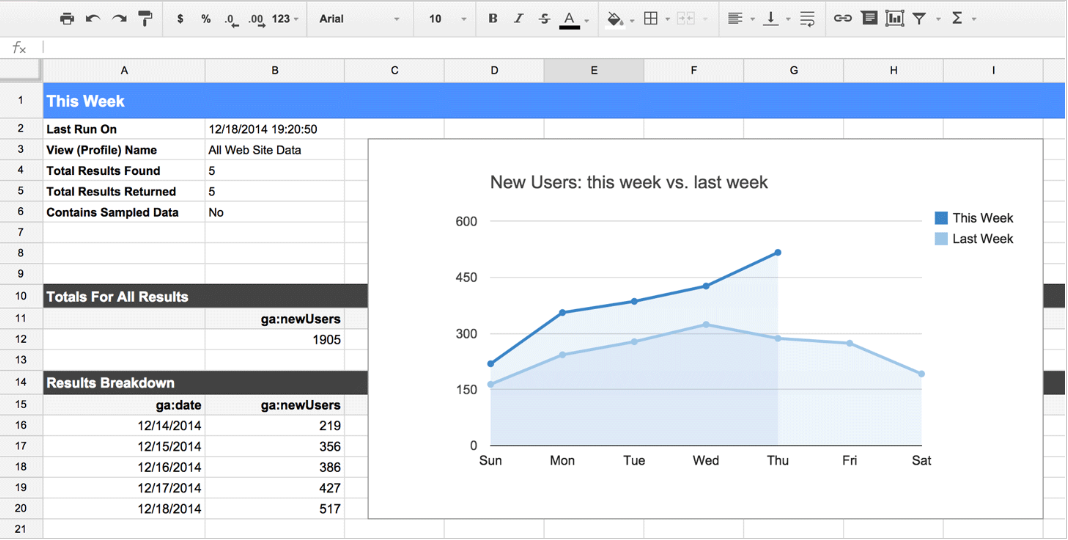
APIs are extremely useful when you deal with vast data. And what if you need to get the results here and now? In these cases, browser extensions will be handy. They help quickly analyze your page, find technical issues, or research keywords without switching between the page and the tools. I’ll share four free SEO extensions for Google Chrome that are essential for marketers.
If you deal with content, you probably know this tool already. If not, it’s the right time to start using it. SEO TextOptimizer measures the quality of your content based on the topic and the words you use in the text.
All you need to do is enter your main keyword into its search field. The extension will show you the optimization score with the words you’d better add or remove from the article.

This SEO extension lets Serpstat users conduct SEO analysis in one click. With it, you can analyze your competitors, get your site’s top-10 keywords, get the data on domain’s traffic, see its visibility trend for a year, and more.
Serpstat SEO & Website Analysis Plugin has three tabs (Page Analysis, On-page SEO Parameters, and Domain Analysis) providing detailed information on each aspect.
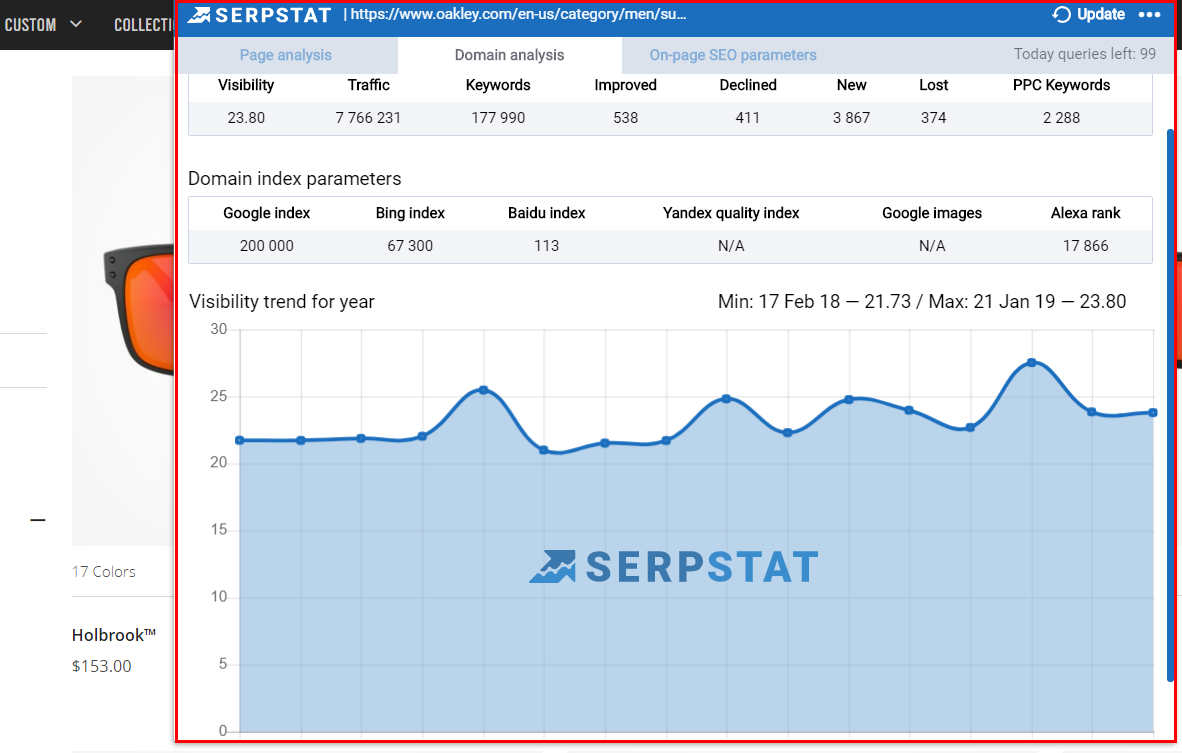
This extension is an interactive SEO dashboard with the SEO overview, backlink report, and other important metrics. However, its best feature is SERP analysis. It means that when searching for the query, you’ll see the bar providing the most crucial domain data below each search result. With SEOquake, you’ll get the following metrics without even clicking through the page:

The SEO and website analysis extension by Woorank is great for a quick analysis of the page’s SEO issues. It identifies crawl errors, usability, mobile friendliness, local directories, and more. The extension evaluates the total score of your marketing efforts and prioritizes all the issues for you to solve.

The more tasks you have to solve, the more difficult it is to manage your time. Don’t limit yourself to SEO tools’ interfaces with the standard set of functions. Implement new methods into your SEO analysis processes to become more productive and save your time on manual work.
Tell us which of these tools have helped you save on precious productive time! Leave a comment below.
Inna Yatsyna is a Brand and Community Development Specialist at Serpstat. She can be found on Twitter .
80% of users admit that a poor search experience can make them leave a web store. How faceted navigation in ecommerce can make or break their experience.
Five strategies to help digital marketers speed up recurring tasks and have more energy to focus on meaningful work. Scripts, excel, bidding, and more.
If there’s one thing that’s universally accepted, it’s that the results of SEO are unpredictable. An overview of SEO forecasting methodology and measurement.
For most marketers, analytics exists in a magic Pandora’s box, encompassing everything from CPCs to CTRs, from algorithms to artificial intelligence, from machine learning to quantum computing — with a bit of blockchain sprinkled in for good measure.
Buzzwords aside, the barriers to incorporating analytics into your life aren’t as high as analytics behemoths may make it seem. To the contrary, once you clarify a few misconceptions, you can make this seemingly enigmatic field not only relevant but also remarkably useful.
Cost is an often-cited obstacle to starting a data journey. Despite the shiny advertisements, you may see for Adobe’s Marketing Cloud (which costs upwards of $100,000 a year) and the dozens of LinkedIn messages you get from martech salespeople; you don’t need Fortune 500 money to take a stab at unlocking analytics. Google Analytics, Google Search Trends, Hotjar and HubSpot are just a few examples of industry-standard platforms that can dramatically improve your decision-making capabilities for free.
Even better, these platforms are made for data amateurs. Their interfaces are straightforward, and if you get lost, there are countless tutorials, help forums, boot camps and even classes to help you. Google also offers a certification program for Google Analytics, complete with videos and walkthroughs. It’s perfect for anyone who needs a place to start.
Marketers often forget that data is merely a tool. Expecting a Google Analytics tag to fix your website is like throwing a hammer at your newly opened IKEA purchase and expecting a sofa to emerge.
In other words: Collecting data is the easy part. Understanding what to do with all this info is where the magic happens.
So, spend a few weeks studying how to interpret data. Bootcamps and classes are always helpful, but the secret that every engineer already knows is that Youtube and Google are your best friend. Dig out your notes from that statistics class in college and learn how to run a simple correlation in Excel. An investment of your time today learning how to interpret data will pay dividends for the rest of our career.
There are no sure things in marketing. Even scientists (and yes, I mean the ones in lab coats) often need years of data collection, rigorous modeling and endless testing to prove a hypothesis. And that’s in a lab. Imagine what happens in the real world, where things are constantly changing and driven by deadlines.
In this chaos, it’s no surprise that data rarely provides a bullet-proof answer. Sure, you can add more expensive technology, but it’s important to remember that, as marketers, we’re dealing in the realm of probability, not exact certitude.
What’s more, it’s okay to be wrong. Take every failure as a badge of honor; minimizing risk does not mean avoiding it entirely. A 95 percent chance of sunshine tomorrow still means that rain is a possibility, but also, your decision to not bring an umbrella isn’t necessarily incorrect. Make peace with the risk as long as you separate logic from emotion. In the long run, your data-driven approach will result in far more wins than losses.
All too often, people associate analytics with reporting. While reporting is critical, it is merely a means to an end. No business has ever been transformed by a single report.
Data is meant to be used as an unbiased means to test something. Nowhere in that definition does it stipulate that you must create daily, weekly or even monthly reports.
As we’ve seen, data takes time to collect. And while you should consistently check your data, it’s up to you to find the reporting cadence that works best for your team.
Then, instead of focusing on frequency, you can focus on presentation quality. Data is like a foreign language; it’s only useful if someone else understands what you’re saying. So, make sure your reports are thoroughly readable. Be concise, use visuals and err on the side of plain language. Above all, always return to the core business problem you’re trying to solve.
Contrary to conventional wisdom, analytics isn’t shorthand for building sophisticated statistical models. Properly understood, analytics is a philosophy that embodies something much simpler: applying the scientific method to test your educated guesses. Whether you’re running a simple paid Facebook campaign or trying to get into shape for that Bahamas cruise this summer, you can leverage data to make more targeted, meaningful choices.
The reason you’ve read this far is that we agree on a key point: every marketer needs to integrate analytics to succeed in this digital world. In an age where it’s hard to keep up with the jargon, I fully empathize with those who view “analytics” as some enormous, mystical beast. On the contrary, understand that analytics is much more like a puppy; managing your data may be a little unruly at first, but with enough consistent training and respect, the lessons you learn will last you a lifetime.
A data journey can start tomorrow with nothing but a problem to solve or a hypothesis to prove (and a laptop with an internet connection).
So tell me, what are you waiting for?
Opinions expressed in this article are those of the guest author and not necessarily Marketing Land. Staff authors are listed here.

In recent years, the nature of SEO has become more and more data-driven, paving the way for innovative trends such as AI or natural language processing.
This has also created opportunities for smart marketers, keen to use everyday tools such as Google Sheets or Excel to automate time-consuming tasks such as redirect mapping.
Thanks to the contribution of Liam White, an SEO colleague of mine always keen on improving efficiency through automation, I started testing and experimenting with the clever Fuzzy Lookup add-in for Excel.
The tool, which allows fuzzy matching of pretty much any set of data, represents a flexible solution for cutting down manual redirects for 404 not-found pages and website migrations.
In this post, we’ll go over the setup instructions and hands-on applications to make the most of the Excel Fuzzy Lookup for SEO.
Getting started with Fuzzy Lookup couldn’t be easier — just visit the Fuzzy Lookup download page and install the add-in onto your machine. System requirements are quite basic. However, the tool is specifically designed for Windows users — so no Mac support for the moment.
Unlike the not-exact match with Vlookup (which matches a set of data with the first result), Fuzzy Lookup operates in a more comprehensive way, scanning all the data first, and then providing a fuzzy matching based on a similarity score.
The score itself is easy to grasp, with a score of one being a perfect match, for instance. This score then decreases with the matching accuracy down to a score of zero where there is no match. Regarding this, it’s advisable not to venture below the 0.5 to 0.6 similarity threshold in the settings, as the results are not consistent enough for a site migration or 404 redirects purpose below that limit.
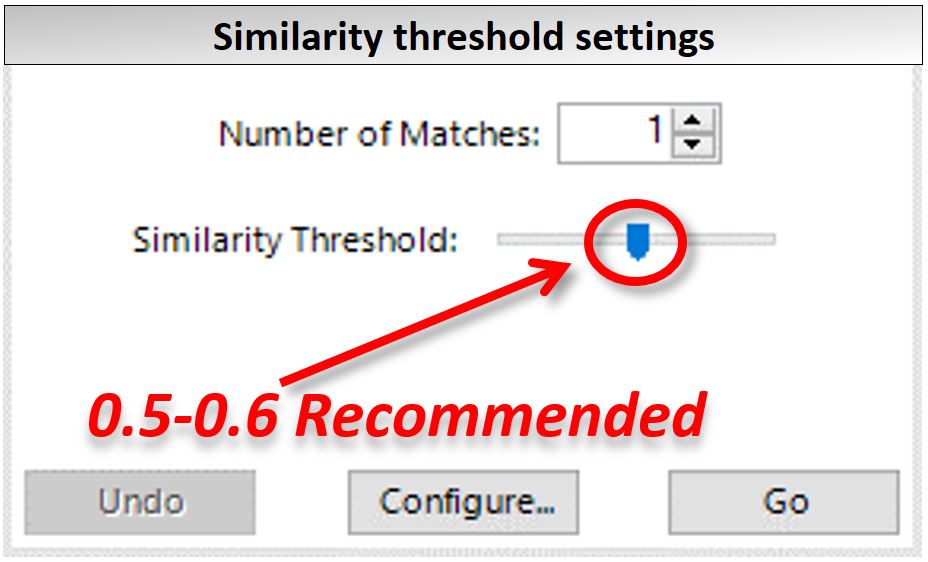
For greater accuracy, it’s also desirable to trim the domain (or staging site equivalent) from the URLs, making sure that the similarity score is not altered by too many commonalities. For more information about the setup, you can also refer to this Fuzzy Lookup guide.
Considering the time necessary to familiarize with the site, categories and products/services, it’s safe to assume that a person would manually match two URLs roughly every thirty seconds. If that doesn’t sound too bad, consider that it would take between five to eight hours for a website of 1,000 URLs. This would make it quite a tedious and time-consuming task.
Bearing in mind that Fuzzy Lookup can provide nearly immediate results with a reliable fuzzy matching for at least 30 to 40 percent of the URLs, then this approach starts to appear interesting. If we consider the savings in terms of time as well, this would translate to about three hours for a small site or over ten hours for large ecommerce site.
If you are changing the structure of a site, consolidating more domains into one, or simply switching to a new platform, then redirect mapping for a website migration is definitely a priority task on your list. Assuming that you already have a list of existing pages plus the new site URLs, then you are all set to go with Fuzzy Lookup for site migrations.
Once you have set up the two URL lists in two separate tables, you can fire up the Fuzzy Lookup and order the matched URLs by the similarity score. In my tests, this has proven to be an effective, time-saving solution, helping in cutting down the manual work by several hours.
As displayed in the screenshot below, the fuzzy matching excelled with product codes and services/goods (such as 20600 and corner-sofas, for example). This allows the matching of IDs with IDs, and the URL with the parent category, in the case where an identical ID is not available.

Pages with a 404 status code are part of the web and no website is immune, hosting at least a few of them. Having said that, 404 errors have the potential of creating problems, hurting the user experience and SEO. Fuzzy Lookup can help with that, requiring just one simple addition a recent crawl of your site to extract the list of live pages, like the example below:

The fuzzy matching works pretty well in this instance too, matching IDs with IDs, and leaving the match to the most relevant category if a similar product/service is not live on the site. As per the site migrations, the manual work is not completely wiped out, but it’s made a whole lot easier than before.
Another interesting application for Excel Fuzzy Lookup can be found in analyzing the blog section. Why? Simply because if you’re not in charge of the blog then you are not likely to be aware of what’s in it now, and what has been written in the past.
This solution works in two ways as well, because if a similarity is found, then you have the confirmation that the topic has been already covered. If not, this means that there’s still room for creating relevant content that can be linked to the service/product category to improve organic reach as well.

Time is money, and when it comes to dealing with large numbers of URLs that need to be redirected, a solution like Fuzzy Lookup can help you in cutting down the tedious manual redirect mapping. Thus, why not embrace fuzzy automation and save time for more exciting SEO tasks?
Marco Bonomo is an SEO & CRO Expert at MediaCom London. He can be found on Twitter .
Five strategies to help digital marketers speed up recurring tasks and have more energy to focus on meaningful work. Scripts, excel, bidding, and more.
If there’s one thing that’s universally accepted, it’s that the results of SEO are unpredictable. An overview of SEO forecasting methodology and measurement.
For large websites like ecommerce, there can be an overwhelming amount of data. Here’s how to pull and audit your search data to know where to grow next.
Ask a digital marketer what their biggest challenges are tied to marketing technology, and it may change given the time of day (or your last conference call). But we’re asking you to help us compile the mother of all lists.
The survey below should take just a few minutes. Just list the big challenges you face, and we’ll come back later to share the full list of what you and your peers had to say.
This story first appeared on MarTech Today. For more on marketing technology, click here.
https://martechtoday.com/what-martech-challenges-are-keeping-you-up-at-night-231869